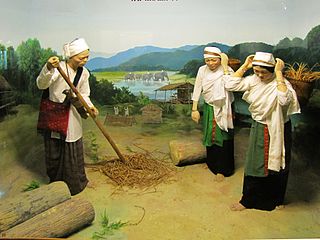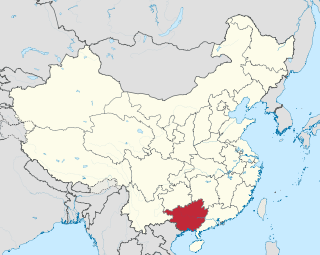
Vietnamese is an Austroasiatic language that originated in Vietnam, where it is the national and official language. It is the native language of the Vietnamese (Kinh) people, as well as a first or second language for the many ethnic minorities of Vietnam. As a result of Vietnamese emigration and cultural influence, Vietnamese speakers are found throughout the world, notably in East and Southeast Asia, North America, Australia and Western Europe. Vietnamese has also been officially recognized as a minority language in the Czech Republic.
Tone is the use of pitch in language to distinguish lexical or grammatical meaning – that is, to distinguish or to inflect words. All verbal languages use pitch to express emotional and other paralinguistic information and to convey emphasis, contrast, and other such features in what is called intonation, but not all languages use tones to distinguish words or their inflections, analogously to consonants and vowels. Languages that do have this feature are called tonal languages; the distinctive tone patterns of such a language are sometimes called tonemes, by analogy with phoneme. Tonal languages are common in East and Southeast Asia, the Pacific, Africa, and the Americas; as many as seventy percent of world languages may be tonal.

Thai, Central Thai, is the sole official and national language of Thailand and the first language of the Central Thai people and vast majority of Thai Chinese. It is a member of the Tai group of the Kra–Dai language family. Over half of Thai vocabulary is derived from or borrowed from Pali, Sanskrit, Mon and Old Khmer. It is a tonal and analytic language, similar to Chinese and Vietnamese.
Northern Thai, Lanna, or Kam Mueang is the language of the Northern Thai people of Lanna, Thailand. It is a Southwestern Tai language that is phonotactically closely related to Lao. Northern Thai has approximately six million speakers, most of whom live in the native Northern Thailand, with a smaller community of Lanna speakers in northwestern Laos.

The Ahom script is an abugida that is used to write the Ahom language, a nearly-extinct Tai language spoken by the Ahom people who ruled eastern part of Brahmaputra valley—about one-third of the length of Brahmaputra valley—in the Indian state of Assam between the 13th and the 18th centuries. It is also called Tai Ahom Script.

The Ahom, or Tai-Ahom is an ethnic group found today in Assam and Arunachal Pradesh. They are the descendants of the Tai people who reached the Brahmaputra valley of Assam in 1228. Currently, they represent the largest Tai group in India, with a population of nearly 1.3 million in Assam. Ahom people are found mostly in Upper Assam in the districts of Golaghat, Jorhat, Sibsagar, Dibrugarh, Tinsukia ; and in Lakhimpur, Sonitpur and Dhemaji (north). There is a significant presence in Karbi Anglong and Lohit District of Arunachal Pradesh.
The Ahom language is a dead language that was spoken by the Ahom people that is undergoing revivalism. The Ahom people established the Ahom kingdom and ruled the Brahmaputra river valley in the present day Indian state of Assam between the 13th and the 18th centuries. The language was the court language of the kingdom, till it began to be replaced by Assamese language in the 17th century. Since the early 18th century, there has been no native speakers of the language, though extensive manuscripts in the language still exists today. The tonal system of the language is entirely lost. The language was only partially known by a small group of traditional priests of the Ahom religion and it was being used only for ceremonial or ritualistic purposes.
The Shan language, Shan spoken: ၵႂၢမ်းတႆး, pronounced [kwáːm táj](listen)), or ၽႃႇသႃႇတႆး, pronounced [pʰàːsʰàː táj]; Burmese: ရှမ်းဘာသာ, pronounced [ʃáɴ bàðà]; Thai: ภาษาไทใหญ่, pronounced [pʰāː.sǎː.tʰāj.jàj]) is the native language of the Shan people and is mostly spoken in Shan State, Burma. It is also spoken in pockets of Kachin State in Burma, in northern Thailand, and decreasingly in Assam. Shan is a member of the Tai–Kadai language family, and is related to Thai. It has five tones, which do not correspond exactly to Thai tones, plus a "sixth tone" used for emphasis. It is called Tai Yai, or Tai Long in the Tai languages.
Mongsen Ao is a member of the Ao languages, a branch of the Sino-Tibetan languages, predominantly spoken in central Mokokchung district of Nagaland, northeast India. Its speakers see the language as one of two varieties of a greater "Ao language," along with the prestige variety Chungli Ao.

Khamti language is a Southwestern Tai language spoken in Burma and India by the Khamti people.
Tai Phake, also known as Phakial or simply Phake, belong to the Tai-speaking indigenous ethnic group living in Dibrugarh district and Tinsukia district of Assam, principally along the areas of Dihing river as well as adjacent parts of Lohit and Changlang district in Arunachal Pradesh. As of 1990, their population stood at 5,000, which consists of less than 250 families.
The Karen or Karenic languages, are tonal languages spoken by some seven million Karen people. They are of unclear affiliation within the Sino-Tibetan languages. The Karen languages are written using the Burmese script. The three main branches are Sgaw, Pwo and Pa'o. Karenni and Kayan are related to the Sgaw branch. They are unusual among the Sino-Tibetan languages in having a subject–verb–object word order; other than Karen, Bai and the Chinese languages, Sino-Tibetan languages have a subject–object–verb order. This is likely due to influence from neighboring Mon and Tai languages.

E or Wuse/Wusehua is a Tai–Chinese mixed language spoken primarily in Rongshui Miao Autonomous County, Guangxi, China. It contains features of both Tai and Chinese varieties, generally adopting Chinese vocabulary into Tai grammar. E is a tonal language—distinguishing between seven tones—and contains a few rare phonemes: voiceless versions of the more common nasal consonants and alveolar lateral approximant.
Khamyang is a critically endangered Tai language of India, spoken by the Khamyang people. Approximately fifty people speak the language; all reside in the village of Powaimukh, located seven miles downstream of Margherita in the Tinsukia district. It is closely related to the other Tai languages in the Assam region: Aiton, Khamti, Phake, and Turung.
The Turung language is an extinct Tai language formerly spoken in Assam. The Turung people who spoke this language now speak Assamese or Singpho languages.
Proto-Tai is the reconstructed proto-language of all the Tai languages, including modern Lao, Shan, Tai Lü, Tai Dam, Ahom, Northern Thai, Standard Thai, Bouyei, and Zhuang. The Proto-Tai language is not directly attested by any surviving texts, but has been reconstructed using the comparative method.

The Southwestern Tai, Southwestern Thai or Thais languages are an established branch of the Tai languages of Southeast Asia. They include Siamese, Lanna, Lao, Isan, Shan and others.
The Tai Phake language is spoken in the Buri Dihing Valley of Assam, India. The corresponds to the modern Thai บ้าน, ban, and Shan ဝၢၼ်ႈ wan which corresponds to 'village'.
Kyirong is a language from the subgroup of Tibetic languages spoken in the Kyirung district of the Shigatse prefecture, of the Tibetan Autonomous Region. Language structure

The languages of Mainland Southeast Asia (MSEA) form a linguistic area, which stretches from Thailand to China and spans the Sino-Tibetan, Hmong–Mien, Kra–Dai, Austronesian and Austroasiatic families. Neighbouring languages across these families, though presumed unrelated, often have similar typological features, which are believed to have spread by diffusion. James Matisoff referred to this area as the Sinosphere, contrasted with the "Indosphere", but viewed it as a zone of mutual influence in the ancient period. "Sinosphere" is more commonly used to refer to the East Asian cultural sphere.









